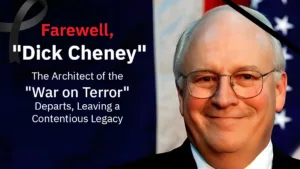Farewell, “Dick Cheney”: The Architect of the “War on Terror” Departs, Leaving a Contentious Legacy
By D. Kholoud Mahmoud

In the corridors of power in Washington, Dick Cheney emerged as a uniquely formidable figure—a man who not only sought to understand the mechanisms of power but endeavored to reshape them according to his own vision. Cheney was no conventional politician. He was the strategic architect of the “imperial presidency,” a philosopher of the “doctrine of necessity” in foreign policy, and a tenacious fighter in domestic and international battles from which he never emerged unscathed.
Cheney’s career resembles an epic tale of ascent, power, and controversy—from his office in the White House as the youngest Chief of Staff in American history, to the war room of the Pentagon during Desert Storm, all the way to the vice presidency, where he became the most powerful vice president America has ever known. Yet, this story is fraught with profound contradictions: a man who suffered five heart attacks yet commanded the world’s most powerful security apparatus; a politician schooled in constitutional law who pushed its limits to the edge; a traditional conservative who became a symbol of revolution in concepts of sovereignty and freedom.
Early Trajectory and Rise to Prominence
Richard Bruce “Dick” Cheney was born on January 30, 1941, in Lincoln, Nebraska. In his youth, he was an unremarkable student who struggled academically before finding his footing in political science at the University of Wyoming. His early training in the Nixon administration laid the foundation for his deep understanding of power dynamics in Washington. He rose rapidly through government ranks, becoming, in 1975 at just thirty-four years old, the youngest White House Chief of Staff in American history under President Gerald Ford. This period was not merely a job title; it was a decisive chapter that honed his philosophy, one that prioritized executive authority and national security above all else.
Before becoming Vice President, Cheney forged an intensive legislative career. Serving as Wyoming’s representative in the House from 1979 to 1989, he earned a reputation as a steadfast and pragmatic conservative. However, his most influential role was as Secretary of Defense under President George H. W. Bush from 1989 to 1993. In this position, he oversaw one of the most meticulously planned and decisive U.S. military operations of the modern era: Operation Desert Storm to liberate Kuwait in 1991. This experience reinforced his conviction that American military power, when applied with force and resolve, could redraw the geopolitical map.
Yet, it is his tenure as Vice President to George W. Bush (2001-2009) that is universally regarded as his most impactful and controversial. Cheney was no traditional vice president; he was, by most accounts, the “most powerful vice president” in American history. In the aftermath of the September 11 attacks, he became the chief architect of the so-called “War on Terror.”
The Dramatic Personal Battle
While his political life was marked by calculated maneuvers, perhaps the most dramatic aspect of Cheney’s life was his health. From his first heart attack at age thirty-seven, he embarked on an extraordinary medical journey. He endured five heart attacks in total, progressing to advanced congestive heart failure. In 2012, at seventy-one years old, he underwent a heart transplant—a decision that itself sparked ethical debate regarding priority for older patients on transplant lists. This long battle with illness reveals a man who confronted death repeatedly, a fact that some analysts believe explains the unwavering resolve and conviction he displayed in his political battles.
A Complex Legacy
After leaving office, Cheney did not vanish from public life. He authored his memoirs, appeared in the media, and transitioned into the role of critic from within the Republican Party. The supreme irony is that his most severe criticisms were later directed at President Donald Trump, whom Cheney saw as a threat to the very conservative traditions and institutions he had defended throughout his life.
In the end, he remains a political figure who inspires both admiration and opposition.
· To his supporters, he was a resolute statesman who upheld the banner of national security in the darkest of times and was unafraid to make difficult decisions to protect the nation.
· To his critics, he is the embodiment of the dangers of unchecked power, a man who inflicted severe damage on America’s reputation and values, and who championed policies that left behind thousands of casualties and endless wars.
Today, his journey concludes amidst this enduring mix of endorsement and rejection, as the final curtain falls on his life with his death on November 3, 2025.



